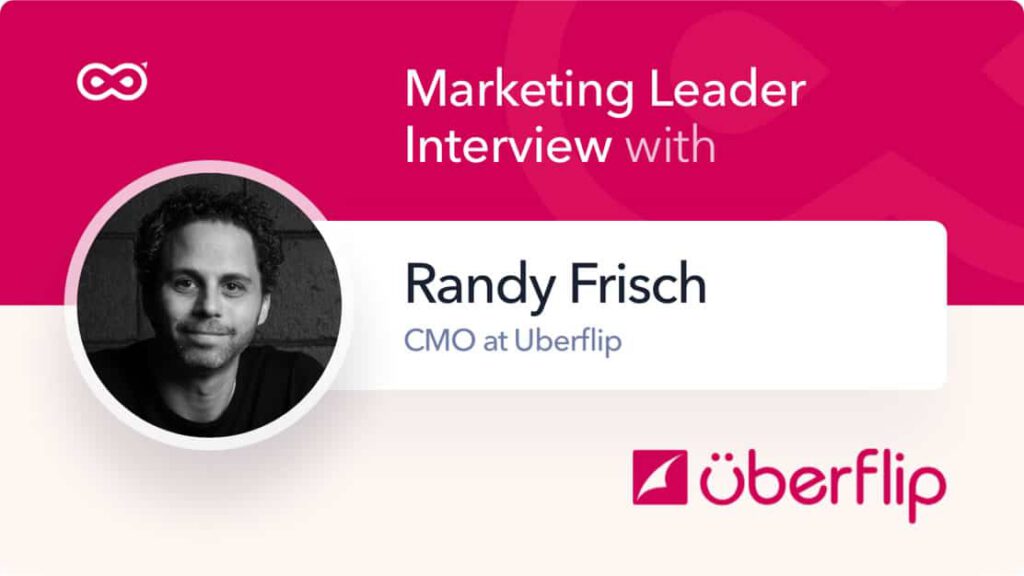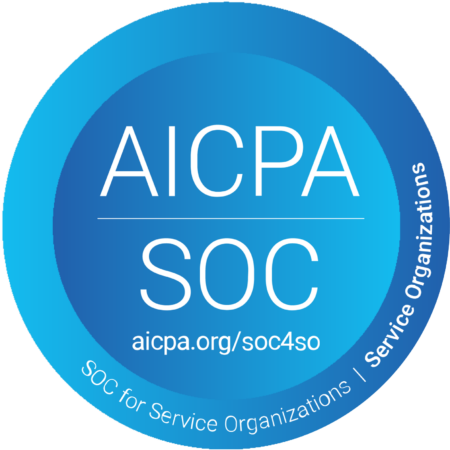We’re back with the latest edition of Q&A with Marketing Leaders, our interview series built to provide SaaS marketing leaders with the best insights and actionable tips on how to improve their marketing planning by learning from the best marketers in the industry.
In this edition, we spoke with Randy Frisch, Chief Marketing Officer at Uberflip.
Uberflip is the world’s #1 Content Experience Platform (CEP). With tools to aggregate all your marketing content, they empower B2B marketing and sales teams to create personalized content experiences to engage accounts, nurture prospects, and convert leads, without the help of IT. Their mission is to put control back in the hands of marketing teams to deliver high-converting experiences, that put the customer front and center.
Randy Frisch is the CMO and Co-Founder of Uberflip. He has defined and led the content experience movement, prompting marketers to think beyond content creation and truly put their customers first by focusing on the experience.
This movement has fuelled an annual conference, Conex: The Content Experience, that brings together 750+ passionate marketers, and a North American-wide Conex Tour. Randy is also a host of Conex: The Content Experience Show podcast, was named one of the Top 50 Fearless Marketers in the world by Marketo and is the best-selling author of F#ck Content Marketing: Focus on Content Experience.
What was the best marketing advice that you got in your career?
I grew up wanting to be a marketer because, as a little kid, I loved Super Bowl commercials. What amazed me about them was the creativity that went into making them a story that intrigued me and kept me watching versus changing the channel.
I think the advice that I’ve gotten along the way very much aligns with this. It is this idea of, “Is what you’re putting out there click-worthy? Is it the type of thing that you yourself would engage in?”
I think a lot of us feel a responsibility to create content, to send emails, to post on social and to have a voice and be present in the conversation at all times, versus actually having something to say that someone will listen to. That’s something that we need to challenge ourselves with on a regular basis. Ask yourself if what you’re doing is going to impact your audience?
If you do that, you will connect with people, people will value you as a marketer and you will advance in your career regardless of whether your job is in data analysis or on the creative side of things.
What is the most common marketing mistake you see?
I’ll kind of tie this back to the previous answer but from a bit of a different angle. I think the biggest mistake we make is not leveraging the valuable content that we have. We just try and create more and more and more.
A stat from SiriusDecisions (now part of Forrester) says that 70% of content created goes unused. That doesn’t mean that we don’t post it to our website, but we need to contextualize it for the campaigns we’re using. We need to take time to leverage the content that we have in more meaningful ways. We need to think about the environment, the structure and the way we engage at the end of the day to create a compelling content experience.
It’s not just about what’s working, it’s also about trying new things. A lot of that now comes down to data and the ability to track. We use marketing automation, we use marketing attribution and also leverage our finance team and their expertise in BI
How is marketing going to change in the next five years in your opinion?
Well, it’s funny. I did a trends report going into 2019 and looked at a lot of the trends, but what I did is I actually went back and looked at the trends of 2009–10 years prior. It was wild to see how different things were!
At that point, a lot of people were saying that content marketing is something that you should look at and create your own content teams. A lot of us have gotten there but we’re still ramping up in some ways and that took 10 years! I think in five years from now, we’re going to start to see a shift from purely content creation to how content is more strategically intertwined into our marketing campaigns. We’ll also start to see more sophistication in how AI makes personalization possible, and with that will come an expectation that we can serve people the right content at the right time at the right place as opposed to the experiences we often give today where people have to go searching through menu bars to find the content.
The experiences that we’ll get to will reflect more of a Netflix or Spotify, where we get there and they already have a benchmark for what type of movie or music we want. Same thing, what type of business content we may want to serve.
What advice would you give someone looking to become a marketing leader one day?
I think we have to be careful who we’d look for as a marketing leader.
Marketing is no longer the “Mad Men” marketing that we see on TV. Marketing is responsible for arming and enabling all different parts of the organization. Obviously, that starts with Sales. We hear so much about marketing and sales alignment, but it continues into customer marketing and customer engagement or customer success. I think the best marketing leaders are the ones that have taken time to sit in roles outside of marketing.
Some of the best marketers on my own marketing team have spent time in customer success and sales roles. They have context to the challenges that people see on the other side.
As you think about becoming a marketing leader, consider if it makes sense to take detours within your organization to get a better context of what’s happening outside of marketing.
How do you align your marketing team around Uberflip’s business goals?
There are business goals and there are also core values. It’s important to look at both of them. One of our core values here at Uberflip is to create great experiences. We talk about that in our product and in terms of how we interact with our customers on so many different levels.
One of the overarching goals for our marketing team is to make sure that anything that goes out is a great experience. It’s almost a stamp of approval. We have to self assess before something goes out the door.
Some of our business goals get more into revenue, retention and other aspects like that. When we look at those, the key is really making sure that we align our goals with the goals of the individuals and other departments. Take sales for example. There’s nothing worse than our team celebrating hitting a target, or the sales team celebrating hitting a target, and the other group feeling like they didn’t hit a target. The two should be aligned and we should celebrate these wins together.
There’s a tricky thing going on in marketing today, which is that we somewhat justify everything we do is warranted as long as it has a touch point in the customer journey. We really have to be able to dig down into the data to see what is actually moving the needle.
What is your process for building your marketing strategy?
As I said earlier, marketing strategy needs to serve the purpose and goals of the company. I was actually chatting with an HR leader recently and they asked me how I prioritize headcount. I said that we actually have three pretty big strategies that we need to look at. One is that we need to build revenue. We need to build and retain revenue, which would suggest we need to hire a lot of sales people and a lot of customer support people and success people.
Another strategy, and priority for us, is that we need to build a movement, build a category, so we spent a lot of time and a lot of resources interacting with analysts, and talking to influencers in our space. That requires a lot of budget and even a lot of headcount to manage.
The last aspect is that we’re a product company. We build an amazing product to enable marketers, so we need the right technical resources. The tricky part is balancing all of those in. This HR individual asked me, “well which one would you invest in if you could only invest in one?” I said, “I can’t invest in one. I have to invest in all three.” The same thing comes down to our marketing strategy. It’s not enough to put all of your attention into generating leads or generating pipeline because if you put all of your attention there, then you’re going to ignore what happens when they become a customer. We’re going to let them down if we don’t have the right product, product support, etc.
It’s essential to have our marketing team focus on those different areas, that there’s a voice for every part of the business.
How do you decide what marketing channels belong in your marketing plan?
I think all of us could definitely improve on this one. We definitely have channels that we know work, and we also have channels that we’re exploring. One of our themes for this year is to explore the unknown. It’s not just about what’s working, it’s also about trying new things. A lot of that now comes down to data and the ability to track. We use marketing automation, we use marketing attribution and also leverage our finance team and their expertise in BI (business intelligence).
The key is being able to look at a channel and see the influence. There’s a tricky thing going on in marketing today, which is that we somewhat justify everything we do is warranted as long as it has a touch point in the customer journey. But we really have to be able to dig down into the data to see what is actually moving the needle, otherwise, we end up spending on too many channels and losing focus.
How do you know that you planned well?
Well, it’s kind of hard at times because the easy answer here is to say we’re hitting targets, right? But sometimes the reality is that if you look at our pipeline and our sales velocity, what we do today may not impact for six to 12 months so I think a key thing for planning is setting goals up front and being able to evaluate them as you go. Too often, we just throw a whole bunch of things up in the air, and we cross our fingers, and at the end of the quarter, we look at the results. We need to have more of a forecast approach.
A lot of sales organizations are built on this, but too many marketing teams don’t take enough time to really think about what are they aiming to get from the different channels that they invest in.
I think a key thing for planning is setting goals up front and being able to evaluate them as you go. Too often, we just throw a whole bunch of things up in the air, and we cross our fingers, and at the end of the quarter, we look at the results. We need to have more of a forecast approach.
How often do you adjust your marketing plan after you create it?
Our marketing plan is being evaluated on a daily basis. One of the things that we’re trying to do a better job at is leaving room for new projects. Sometimes there are great opportunities that come our way and we need to be able to take advantage of them as they come.
It’s very important to be open and flexible, but your team needs direction. When we do a lot of our planning and our goal-setting on a quarterly basis, we have metrics that people are going after and we also have core projects. In all likelihood, those core projects are set and not moving but there are also items that touch multiple members of the marketing team so that everyone feels connected to the outcomes.
What is your best advice for a young CMO in terms of marketing planning?
There’s a very important aspect to understand about being a CMO. We often think that our job as a CMO is to run the marketing team. That’s absolutely a big part of it but the other aspect is that you’re part of a different team, you’re part of the C suite, the executive team. Many of us ignore the importance of aligning ourselves with the other executives in the room, knowing what the sales team is focused on, knowing what the success team needs, knowing what products are coming down the pipeline that we’re going to have to support.
We don’t value enough the time that we get to spend with the other executives to align out of the gate. That, to me, is how we all come back to this idea of planning for great outcomes.



